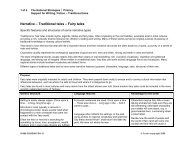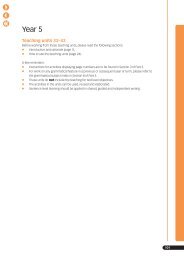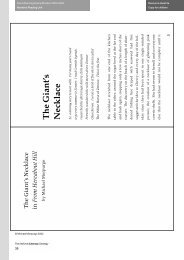You also want an ePaper? Increase the reach of your titles
YUMPU automatically turns print PDFs into web optimized ePapers that Google loves.
It happened<br />
like this …<br />
<strong>Writing</strong> <strong>Flier</strong> 5<br />
Recount<br />
Recount writing is often seen as the easiest non-fiction text<br />
type to teach, since recounts are organised chronologically,<br />
like a story. There are many occasions when children have a<br />
‘true story’ to write, e.g.<br />
� accounts of schoolwork or outings<br />
� events from history or RE<br />
� anecdotes and personal accounts<br />
� biographical writing in any curricular area.<br />
However, chronological writing is not without its pitfalls. All<br />
teachers are familiar with young writers’ accounts of school<br />
trips that deal admirably with the bus journey but omit to<br />
mention what happened later on. Some children, even in<br />
upper primary, have difficulty ordering events appropriately<br />
in more complex historical or biographical recounts.<br />
Most children therefore benefit from organising the facts as<br />
notes on a timeline (or another sequenced framework)<br />
before writing. This provides<br />
� an opportunity to sort out the main events, and their<br />
sequence, without the added effort of putting them into<br />
sentences<br />
� an overview of all the events, in clear chronological<br />
order, so the author knows exactly how much he or she<br />
has to cover (and doesn’t get stuck on the bus)<br />
� an opportunity to consider how to divide the information<br />
into paragraphs before beginning to write<br />
National<br />
Literacy<br />
Strategy<br />
Role-play, drama, story telling or puppetry provides<br />
opportunities for pupils to rehearse and internalise the facts<br />
of a historical event before writing.<br />
� an opportunity to decide whether to follow a linear chronological structure or to adapt the time sequence for effect,<br />
e.g. starting with a key event in a biography.<br />
If an appropriate recount note-taking format or ‘skeleton’ outline (such as the timeline) is used, the structure of these notes<br />
provides a bridge into the structure of the extended written recount. Chronological notes from any subject area can be<br />
used to provide the content for purposeful recount writing.<br />
department for<br />
education and skills<br />
Find out more about recounts<br />
�Further case studies can be found on the NLS website:<br />
www.standards.dfes.gov.uk/literacy.<br />
See also pages 154-155, Grammar for writing and Developing early<br />
writing.








